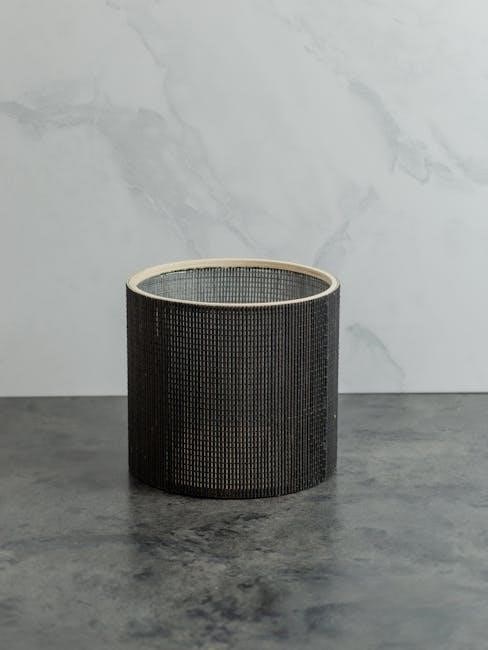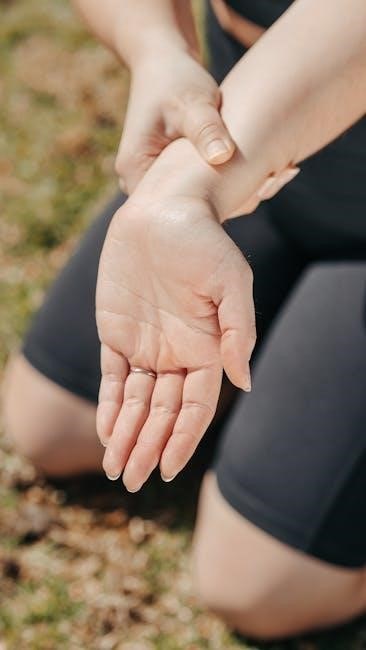Round ligament pain is a common discomfort during pregnancy, caused by uterine expansion and ligament stretching. It’s generally harmless but can be uncomfortable. This section explores its causes, symptoms, and relief strategies to help you manage it effectively.
1.1 What is Round Ligament Pain?
Round ligament pain is a common pregnancy-related discomfort caused by the stretching of ligaments supporting the uterus. As the uterus expands, the round ligaments stretch to accommodate the growing fetus, often resulting in sharp or dull pain in the lower abdomen or groin area. This pain is typically temporary and harmless, though it can feel unsettling. It is most prevalent during the second trimester and is linked to the body’s natural hormonal changes, which relax ligaments to support pregnancy.
1.2 Why is it Common During Pregnancy?
Round ligament pain is common during pregnancy due to the natural expansion of the uterus, which causes the round ligaments to stretch. These ligaments, essential for uterine support, experience increased tension as the uterus grows, especially during the second trimester. Hormonal changes, such as the release of relaxin, further relax the ligaments, making them more prone to discomfort. Sudden movements can exacerbate this pain, making it a frequent experience for many pregnant women. This physiological process, while uncomfortable, is generally harmless and a natural part of pregnancy.
Understanding the Anatomy
The round ligaments are fibrous cords that support the uterus, connecting it to the groin. They stretch during pregnancy, accommodating uterine growth, which can cause discomfort.
2.1 The Role of Round Ligaments in Pregnancy
The round ligaments are fibrous cords supporting the uterus during pregnancy, connecting it to the pelvic bones. They stretch as the uterus grows, maintaining its position and stability. This stretching is necessary to accommodate the expanding uterus, ensuring proper fetal development. While this process is natural, it can cause discomfort, making understanding their role essential for managing pregnancy-related pains effectively.
2.2 How Ligaments Stretch During Pregnancy
During pregnancy, round ligaments gradually stretch to accommodate the expanding uterus; Hormonal changes increase ligament elasticity, allowing them to extend without tearing. This stretching occurs primarily in the second trimester as the uterus grows. The ligaments support the uterus, ensuring proper fetal positioning. While necessary, this process can cause discomfort. Understanding the natural, gradual stretching helps manage expectations and alleviate concerns about ligament-related pain during pregnancy.

Causes of Round Ligament Pain
Round ligament pain arises from uterine expansion and ligament stretching during pregnancy. Hormonal changes relax ligaments, making them prone to irritation. This natural process supports the growing uterus but can cause discomfort. Understanding the causes helps in managing the pain effectively.
3.1 Uterine Expansion and Ligament Stretching
As the uterus grows during pregnancy, the round ligaments stretch to accommodate the expanding uterus. This natural process can cause discomfort or pain, particularly in the lower abdomen or groin area. The ligaments, which support the uterus, are subjected to increased tension, leading to irritation. This stretching is a normal part of pregnancy but can result in sharp or dull pains, often described as feeling like a rubber band stretching inside the belly.
3.2 Hormonal Changes and Ligament Relaxation
During pregnancy, hormonal changes, particularly the increase in relaxin, cause ligaments to relax and become more flexible. This natural process prepares the body for childbirth but can lead to round ligament pain as the ligaments stretch more easily. The relaxation of ligaments, combined with uterine expansion, increases the likelihood of discomfort or pain, especially during sudden movements. This hormonal effect is essential for pregnancy but can contribute to the sensation of ligament irritation.
When Does Round Ligament Pain Occur?
Round ligament pain commonly occurs during the second trimester but can appear at any stage of pregnancy. Sudden movements often trigger this discomfort.
4.1 Timing in Pregnancy (First vs. Second Trimester)
Round ligament pain is most common during the second trimester, around weeks 14–27, due to rapid uterine growth. While it can occur in the first trimester, it’s less frequent. The second trimester sees heightened ligament stretching and hormonal changes, making the pain more noticeable. Sudden movements often trigger discomfort, emphasizing the need for gentle movements and stretching exercises to alleviate tension. This timing is crucial for understanding when to expect and manage the pain effectively.
4.2 Triggers for Sudden Pain
Sudden round ligament pain often occurs with quick movements, such as standing up too fast, coughing, or sneezing. These actions cause abrupt stretching of the ligaments, leading to sharp discomfort. Changing positions rapidly or twisting can also trigger pain. Additionally, heavy lifting or bending may exacerbate ligament irritation. Being mindful of movements and practicing gentle, controlled actions can help minimize these triggers and reduce discomfort during pregnancy. Regular stretching exercises can also improve ligament flexibility.
Symptoms of Round Ligament Pain
Round ligament pain causes sharp or dull discomfort in the lower abdomen and groin. It’s typically brief but can feel alarming due to sudden onset.
5.1 Sharp or Dull Pain in the Lower Abdomen
Round ligament pain often presents as sharp or dull discomfort in the lower abdomen. It may feel like a stabbing sensation or a mild ache, typically on one or both sides. This pain can radiate to the groin or pelvic area due to the ligaments connecting the uterus to the groin. While it’s usually brief, it can be unsettling. Understanding this symptom helps differentiate it from other pregnancy-related discomforts, ensuring appropriate management and reassurance.
5.2 Pain in the Groin or Pelvic Area
Pain in the groin or pelvic area is another common symptom of round ligament pain. This discomfort occurs as the ligaments stretch and pull, often radiating from the lower abdomen to the groin or pelvic region. It may feel sharp or dull, depending on the intensity of the ligament irritation. This type of pain is usually temporary but can be unsettling. Recognizing it as related to round ligament stretching helps women manage it effectively and differentiate it from other pregnancy-related discomforts. Consulting a healthcare provider is advisable if pain persists.
Differentiating Round Ligament Pain from Other Pains
Round ligament pain is typically temporary and sharp, unlike persistent or severe pains associated with conditions like preterm labor or placental issues; Recognizing its characteristics helps distinguish it from other discomforts.
6.1 Comparing with Braxton Hicks Contractions
Round ligament pain and Braxton Hicks contractions are both common during pregnancy but differ in nature. Braxton Hicks contractions are mild, irregular tightenings of the uterus, often feeling like a hardening of the abdomen. In contrast, round ligament pain is typically sharp or dull, localized to the lower abdomen or groin. While Braxton Hicks prepare the uterus for labor, round ligament pain results from ligament stretching. Understanding these differences helps in identifying and managing discomfort effectively during pregnancy.
6.2 When to Worry About Abdominal Pain
While round ligament pain is typically harmless, it’s important to recognize when abdominal pain may indicate a more serious issue. Severe, persistent pain, vaginal bleeding, or contractions could signal complications like preterm labor or placental abruption. If pain is accompanied by fever, nausea, or dizziness, seek immediate medical attention. Always consult your healthcare provider if you’re unsure, as distinguishing between normal discomfort and potential risks is crucial for a healthy pregnancy outcome.
Prevention and Relief Strategies
Gentle stretching and maintaining proper posture are key to preventing and relieving round ligament pain. Regular exercises can help reduce discomfort and support your body during pregnancy.
7.1 Gentle Stretching Exercises
Gentle stretching exercises are effective for alleviating round ligament pain. Cat-cow stretches, hip flexor stretches, and butterfly stretches are recommended to loosen tight muscles and improve flexibility. These exercises target the lower abdomen, hips, and pelvis, areas commonly affected by ligament stretching. Holding each stretch for 30 seconds and repeating 2-3 times can provide relief. Moving slowly and avoiding bouncing ensures comfort and prevents further discomfort; Incorporating these stretches into your daily routine can help manage round ligament pain effectively.
7.2 Maintaining Good Posture
Maintaining good posture is crucial during pregnancy to reduce round ligament pain. Standing tall and avoiding slouching helps distribute weight evenly, minimizing strain on the ligaments. When sitting, use a supportive chair and place feet flat on the floor or a stool. Avoid bending or twisting suddenly, as this can exacerbate discomfort. Proper posture supports the lower back and pelvis, helping to alleviate tension and prevent ligament irritation. A maternity belt can also provide additional support and promote better alignment.
Recommended Stretches for Relief
Engage in gentle stretches like Cat-Cow, Hip Flexor, and Butterfly stretches to alleviate round ligament pain. These exercises target the lower abdomen, hips, and pelvis, promoting flexibility and comfort during pregnancy. Regular practice helps reduce tension and discomfort caused by ligament stretching, ensuring a more relaxed and supported prenatal experience. Always perform stretches slowly and within a comfortable range of motion.
8.1 Cat-Cow Stretch for Lower Back and Pelvis
The Cat-Cow stretch is an excellent exercise for relieving round ligament pain. Start on your hands and knees. Inhale as you arch your back, lifting your head and tailbone (Cow pose). Exhale as you round your spine, tucking your chin and pelvis (Cat pose). Repeat 10-15 times. This stretch gently mobilizes the spine and pelvis, reducing tension in the lower back and alleviating discomfort caused by ligament stretching during pregnancy. It’s a safe and effective way to maintain flexibility and promote relaxation. Regular practice can significantly improve posture and reduce stiffness, making it easier to manage daily activities comfortably.
8.2 Hip Flexor Stretches
Hip flexor stretches are highly effective for relieving round ligament pain by targeting the muscles in the hips and lower abdomen. To perform this stretch, kneel on one knee with the other foot in front of you. Gently lean forward, stretching the front of your hip. Hold for 30 seconds and repeat 2-3 times on each side. This stretch helps reduce stiffness, improves flexibility, and alleviates discomfort caused by ligament tension. Regular practice promotes relaxation and supports pelvic alignment, making it easier to manage daily activities during pregnancy.
8.3 Butterfly Stretch for Inner Thighs
The butterfly stretch is a gentle and effective exercise for inner thigh muscles and pelvic relaxation. Sit on the floor with your soles together, knees out wide. Gently press your knees toward the ground while maintaining a straight back. Hold for 30 seconds, breathing deeply. This stretch alleviates round ligament discomfort by loosening tight inner thigh muscles, improving flexibility, and reducing pelvic tension. It’s an excellent way to enhance circulation and prepare the pelvic region for pregnancy changes.
Exercise Ball Stretches
Exercise ball stretches provide excellent support for round ligament relief, allowing gentle stretching and improving posture to alleviate pregnancy discomfort effectively.
9.1 Using an Exercise Ball for Round Ligament Stretch
An exercise ball is a versatile tool for round ligament stretches. Start on your knees, place your hands on the ball, and roll it forward to stretch the lower abdomen and pelvis. This gentle motion helps alleviate tension in the round ligaments, providing quick relief from discomfort. Regular use can improve flexibility and reduce pregnancy-related pain effectively while maintaining proper posture and support.
9.2 Modifying Stretches for Comfort
Modifying stretches is essential for comfort during round ligament pain relief. Adjust the intensity and depth of stretches based on your body’s signals. Incorporate props like pillows or exercise balls for added support. If a stretch feels uncomfortable, stop and consult your healthcare provider to tailor the exercise to your needs. Listening to your body ensures safe and effective relief from round ligament discomfort while maintaining proper alignment and relaxation.

Additional Relief Measures
Additional relief measures for round ligament pain include applying heat or cold therapy and wearing a maternity belt or kinesiology tape for support and reduced discomfort.
10.1 Applying Heat or Cold Therapy
Applying heat or cold therapy can provide significant relief from round ligament pain. Heat therapy, such as using a warm heating pad or taking a soothing bath, helps relax tense muscles and improve blood flow to the area; Cold therapy, like using a cold compress or ice pack wrapped in a cloth, can reduce inflammation and numb the discomfort. Both methods are safe and effective when used correctly, offering immediate comfort during episodes of pain. Always consult your healthcare provider before starting any new therapy to ensure it’s appropriate for your specific situation.
10.2 Wearing a Maternity Belt or Kinesiology Tape
A maternity belt or kinesiology tape can provide additional support to the abdomen and pelvis, alleviating round ligament pain. These tools help distribute the weight of the uterus more evenly, reducing strain on the ligaments. They are particularly useful during physical activity or when standing for long periods. Many women find that wearing a maternity belt or applying kinesiology tape offers stability and comfort, allowing them to move more freely without discomfort. Always choose products designed for pregnancy and follow proper application guidelines to ensure effectiveness and safety.
Safe Exercises During Pregnancy
Safe exercises during pregnancy can enhance comfort and strength. Pelvic circles, forward leaning inversions, and child’s pose with a gym ball are recommended to support your pelvis and improve posture.
11.1 Pelvic Circles and Forward Leaning Inversions
Pelvic circles and forward leaning inversions are excellent exercises to support pelvic alignment and improve posture during pregnancy. To perform pelvic circles, sit or stand tall, engage your core, and gently move your hips in large, slow circles. For forward leaning inversions, bend at the hips and let your arms dangle, stretching your lower back and pelvis. These exercises enhance balance, flexibility, and comfort, while strengthening pelvic muscles. Use a chair or gym ball for added support and stability.
11.2 Child’s Pose with a Gym Ball
Child’s Pose with a gym ball is a soothing stretch that targets the lower back and pelvis, providing relief from round ligament pain. Sit on the floor with your knees wide apart, place the gym ball in front of you, and rest your hands on it. Lean forward gently, stretching your lower back and hips. Hold for 20-30 seconds, breathing deeply to relax. This pose supports spinal alignment and alleviates tension in the pelvic area, promoting comfort and flexibility during pregnancy.

Stretching for Lower Back and Hip Pain
Stretching for lower back and hip pain during pregnancy involves gentle exercises like the Bird Dog stretch to improve flexibility and posture. Move slowly and breathe deeply.
12.1 Bird Dog Stretch
The Bird Dog stretch is an effective exercise for alleviating lower back and hip pain during pregnancy. Start on your hands and knees, then extend one arm and the opposite leg simultaneously. Hold for a few seconds before returning to the starting position. This stretch improves balance, strengthens core muscles, and gently stretches the lower back and hips, providing relief from round ligament discomfort. Perform slowly and avoid any jerky movements for optimal comfort.
12.2 Inner Thigh Stretch
Sit on the floor with your legs bent and knees apart, supporting your upper body with your hands. Gently press your knees toward the ground to stretch the inner thighs. Hold for 20-30 seconds and repeat 2-3 times. This stretch improves flexibility and reduces tension in the pelvic area, providing relief from round ligament pain. Breathe deeply and avoid bouncing to ensure a gentle, effective stretch. Use pillows for support if needed for comfort.
Pelvic Floor Exercises
Pelvic floor exercises strengthen muscles supporting the uterus, bladder, and bowel, enhancing stability and reducing discomfort. Regular practice promotes better posture and alleviates ligament strain during pregnancy.
13.1 Kegel Exercises for Pelvic Support
Kegel exercises strengthen the pelvic floor muscles, providing essential support during pregnancy. To perform them, identify the muscles used to stop urine flow. Squeeze these muscles for 5-10 seconds, then release. Repeat 10-15 times, 3-4 times daily. Regular practice improves bladder control, reduces pelvic discomfort, and enhances overall stability. Consistency is key to maximizing benefits and supporting your body during this period.
13.2 Incorporating Pelvic Floor Work into Daily Routine
Incorporating pelvic floor exercises into your daily routine can be simple and effective. Start by doing Kegels during everyday activities like brushing your teeth or waiting in line. Alternate between quick squeezes and longer holds to build strength and endurance. Use a reminder app or set specific times, such as during commercial breaks while watching TV, to ensure consistency. Over time, these exercises become second nature, providing lasting support and reducing discomfort.

Rest and Relaxation Techniques
Resting and relaxing are crucial for managing round ligament pain. Lie on your side with pillows between your legs and under your belly for support and comfort.
14.1 Sleeping Positions to Alleviate Pain
Sleeping on your side with a pillow between your legs and another under your belly can help alleviate round ligament pain. This position supports your pelvis and uterus, reducing strain on the ligaments. Placing a supportive pillow under your belly helps distribute weight evenly, while the pillow between your legs aligns your hips and pelvis, promoting comfort and reducing discomfort during the night. This simple adjustment can significantly ease pain and improve sleep quality.
14.2 Using Pillows for Support
Using pillows strategically can provide significant relief from round ligament pain. Placing a pillow under your belly while lying on your side helps lift and support your uterus, reducing strain on the ligaments. Additionally, a pillow between your knees or thighs can align your pelvis and hips, easing discomfort. A full-body pillow is especially beneficial, as it offers comprehensive support to your entire body. Experiment with pillow placements to find the most comfortable setup for your needs.
When to Consult a Healthcare Provider
Consult your healthcare provider if experiencing severe or persistent pain, vaginal bleeding, or fever, as these may indicate complications requiring medical attention.
15.1 Signs of Severe Pain or Discomfort
Severe or persistent pain, especially if accompanied by fever, vaginal bleeding, or dizziness, requires immediate medical attention. Sharp, stabbing pains lasting longer than a few seconds or worsening over time may indicate complications. Monitor pain intensity and duration, as unusual symptoms can signal underlying issues beyond round ligament stretching. Always consult your healthcare provider if discomfort interferes with daily activities or escalates suddenly.
15.2 Monitoring Pain Duration and Intensity
Track the duration and intensity of round ligament pain to distinguish it from more serious conditions. Mild discomfort typically subsides within seconds, but prolonged or worsening pain may signal complications. Keep a journal to document episodes, noting when pain occurs, how long it lasts, and its severity. This helps identify patterns and ensures timely medical evaluation if symptoms persist or intensify, preventing potential risks to your health or pregnancy.
Round ligament pain, while uncomfortable, can be effectively managed with gentle stretches and self-care. Prioritize your well-being and consult a healthcare provider if pain persists or worsens unexpectedly.
16.1 Summary of Relief Techniques
Effective relief from round ligament pain involves a combination of gentle stretches, such as Cat-Cow, Hip Flexor, and Butterfly stretches, which target the lower abdomen and pelvis. Using an exercise ball can also provide comfort by allowing controlled movements to ease tension. Additionally, applying heat or cold therapy and wearing a maternity belt or kinesiology tape can offer support and reduce discomfort. Consistent practice of these techniques helps alleviate pain and promotes a more comfortable pregnancy experience.
16.2 Importance of Listening to Your Body
Listening to your body is crucial during pregnancy, as every woman’s experience with round ligament pain is unique.Honoring your physical cues ensures you avoid overexertion and prevent unnecessary discomfort. While stretches and exercises provide relief, it’s essential to stop if pain arises. Ignoring your body’s signals can exacerbate discomfort. Always consult your healthcare provider if pain persists or worsens. By prioritizing your well-being, you support a healthier pregnancy journey and a more comfortable experience overall.
